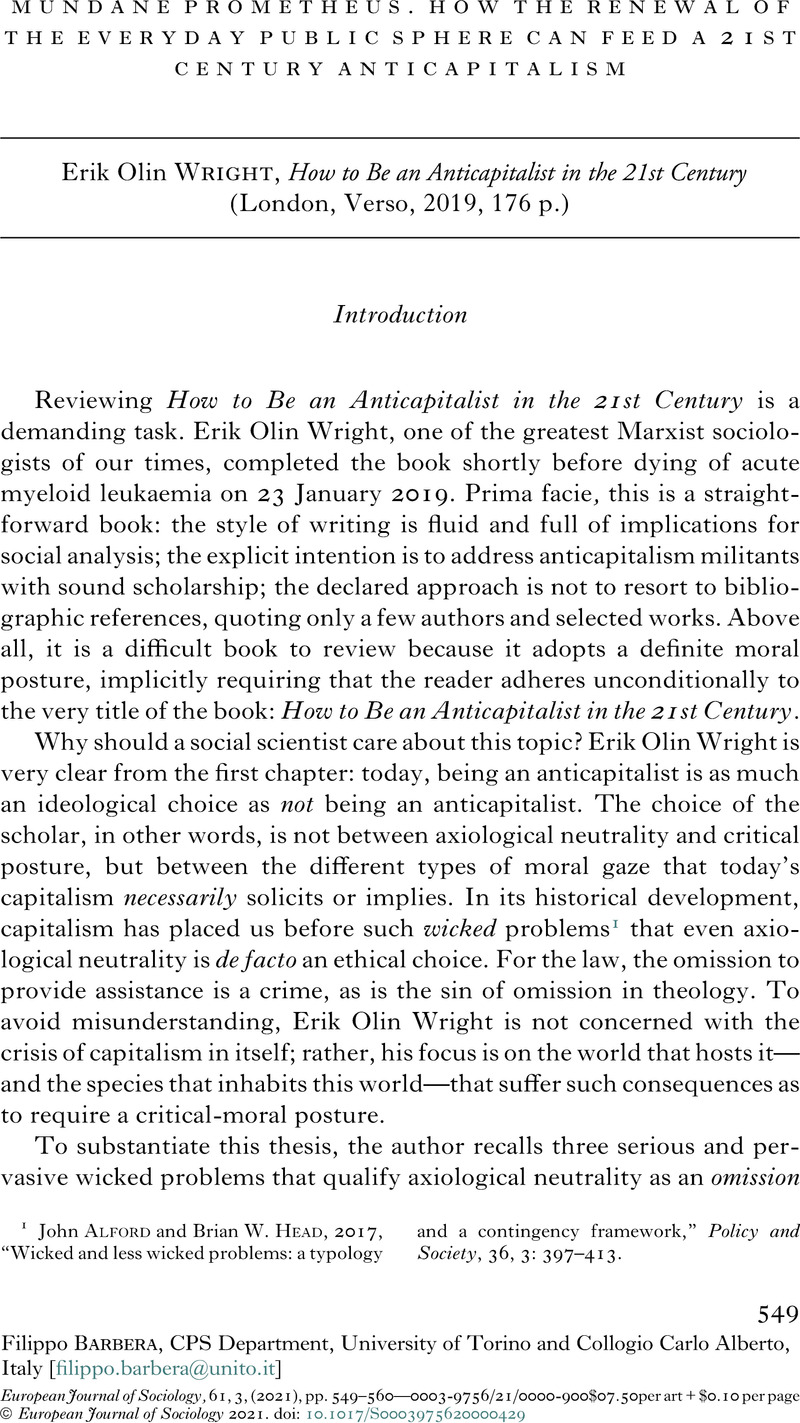Article contents
Mundane Prometheus. How the Renewal of the Everyday Public Sphere can Feed a 21st Century Anticapitalism - Erik Olin Wright, How to Be an Anticapitalist in the 21st Century (London, Verso, 2019, 176 p.)
Review products
Published online by Cambridge University Press: 26 March 2021
Abstract

- Type
- Book Review
- Information
- European Journal of Sociology / Archives Européennes de Sociologie , Volume 61 , Issue 3 , December 2020 , pp. 549 - 560
- Copyright
- © European Journal of Sociology 2021
References
1 Alford, John and Head, Brian W., 2017, “Wicked and less wicked problems: a typology and a contingency framework,” Policy and Society, 36, 3: 397–413CrossRefGoogle Scholar.
2 Bardi, Ugo, 2017, The Seneca Effect: Why Growth Is Slow but Collapse Is Rapid (Cham, Springer).CrossRefGoogle Scholar
3 Piketty, Thomas, 2020, Capital and Ideology (Cambridge/London, Belknap Press).Google Scholar
4 The “foundational economy” refers to the basic goods and services which, through branches and networks, provide the everyday infrastructure of civilized life. The list includes gas and electricity, water, sanitation, retail food supply, telecommunications, health and social care, education, transport systems and housing (Collective for the Foundational Economy 2018, Foundational Economy, Manchester University Press; see also: https://foundationaleconomy.com/).
5 Davies, William, 2014, The limits of neoliberalism (London, Sage).Google Scholar
6 This standpoint is shared with the so-called radical social innovation perspective, which does not believe in structural dogmas and in definitive blueprints for the organization of society (Unger, Roberto M., 2015, “Conclusion: The Task of the Social Innovation Movement”, in Nicholls, Alex, Simon, Julie and Gabriel, Madeleine, eds, New Frontiers in Social Innovation Research (London, Palgrave MacMillan: 233–251CrossRefGoogle Scholar). See also: Erik Olin Wright, 2012, “Transforming Capitalism through Real Utopias” American Sociological Review, XX(X): 1 -25.
7 Wright, Erik Olin, 2010, Envisioning Real Utopias (London/New York, Verso).Google Scholar
8 Zuboff, Shoshana, 2018, The Age of Surveillance Capitalism: The Fight for a Human Future at the New Frontier of Power (New York, Public Affairs).Google Scholar
9 Fourcade, Marion, 2017, “The fly and the cookie: alignment and unhingement in 21st-century capitalism”, Socio-Economic Review, 15 (3): 661–678CrossRefGoogle Scholar.
10 Boltanski, Luc and Thévenot, Laurent, 2006, On Justification. The Economies of Worth (Princeton, Princeton University Press).Google Scholar
11 Stark, David, 2009, The Sense of Dissonance: Accounts of Worth in Economic Life (New York/London, Princeton University Press)CrossRefGoogle Scholar.
12 Barbera, Filippo, Negri, Nicola and Salento, Angelo, eds, 2018, “From individual choice to collective voice. Foundational economy, local commons and citizenship”, Rassegna Italiana di Sociologia, 59 (2): 371–397 [DOI: 10.1423/90584]Google Scholar; Barbera, F. and Jones, Ian Rees, eds, 2020, The Foundational Economy and Citizenship (Bristol, Policy Press)CrossRefGoogle Scholar.
13 Appadurai, Arjun, 2004, “The Capacity to Aspire: Culture and the Terms of Recognition”, in Rao, V. and Walton, M., eds, Culture and Public Action (Palo Alto, Stanford University Press)Google Scholar.
14 Loury, Glenn, 2002, The Anatomy of racial inequality (Harvard, Harvard University Press)Google Scholar.
15 Collins, Randall, 2004, Interaction Ritual Chains (Princeton, Princeton University Press)CrossRefGoogle Scholar.
16 Pizzorno, Alessandro, 2006, “Rational Choice”, in Turner, S. and Risjord, M., eds, Handbook of the Philosophy of Science, 15, Philosophy of Anthropology and Sociology (Dordrecht, Elsevier: 373–395)Google Scholar.
17 Klinenberg, Eric, 2018, Palaces for the people. How social infrastructure can help fight inequality, polarization and the decline of civic life (London, Penguin Random House).Google Scholar
18 Gilbert, Margaret, 2014, Joint Commitment: How We Make the Social World (Oxford University Press, New York)Google Scholar.
19 Brown, Wendy, 2019, In the Ruins of Neoliberalism: The Rise of Antidemocratic Politics in the West (New York, Columbia University Press).CrossRefGoogle Scholar
20 Revelli, Marco, 2019, The New Populism: Democracy Stares into the Abyss (London/New York, Verso).Google Scholar
21 Barbera, Filippo, Negri, Nicola and Salento, Angelo, 2018, “From individual choice to collective voice: foundational economy, local commons and citizenship,” Rassegna italiana di Sociologia, 59, 2: 371–397Google Scholar.
22 Sassen, Saskia, 2014, Expulsions: Brutality and Complexity in the Global Economy (Harvard, Belknap Press)CrossRefGoogle Scholar.
23 Page 301, in Marion Fourcade, M. and Healy, Kieran, 2017, “Seeing Like a Market”, Socio-Economic Review, 15: 9–29Google Scholar.
24 Or, to be more precise, the challenge is to disentangle the “critical consumerism” world in order to highlight if and how it really generates a collective commitment to a shared good. See, for instance, Sassatelli, R., 2015, “Consumer Culture, Sustainability and a New Vision of Consumer Sovereignty,” Sociologia Ruralis, 55, 4: 483–496CrossRefGoogle Scholar; and Barbera, Filippo, Dagnes, Joselle and Monaco, Roberto Di, 2018, “Mimetic quality. Consumer quality conventions and strategic mimicry in food distribution,” International Journal of Sociology of Agriculture and Food, 24, 2: 253–273Google Scholar.
25 de Leonardis, O. 1997, “Declino della sfera pubblica e privatismo”, Rassegna Italiana di Sociologia, 2: 169–193Google Scholar.
26 Coherently with his commitment to “analytical Marxism”.
- 1
- Cited by




